How Teams Can Outperform Using The Startup Ops Pyramid
Most of us have been, or aspire to be, operators of a startup. Operating a startup gives us a sense of autonomy, mastery, and purpose like no other professional track. Of course, we also know that operating a startup isn’t easy. We’ve all heard or experienced the cautionary tales of “blood, sweat, and tears” and the embrace of failure. We also know that success in operating a startup centers mainly around execution. Ideas are cheap, they say.
At BCG Digital Ventures, we recently helped one of our retail corporate partners, a major multi-national company, launch a startup of their own. It is a digital wallet and retail-tech platform that has the potential to transform the consumer purchase journey in their domain. And as is typical in our model at BCGDV, towards the end of our engagement we transitioned our role over to the permanent newco (i.e. startup) team to grow and scale the business. This talented group is now charged with, above all, a single imperative: execution. This responsibility rests with the entire team. From the leadership core, to the engineering pod, to the ethnographers, designers and PMs; individually they are all indispensable operators of our startup. Collectively, like pistons firing up an engine, the timing and alignment of their actions will be all that matters in the growth and prosperity of the newco.
As a Product Owner and GM, I’ve lead several teams over my career in launching digital businesses. The greatest challenge has always been unifying any multi-disciplinary team on a single set of goals. This time in this most recent startup incubation, we did this well. In preparing our transition of our digital wallet business to the permanent corporate newco, and reflecting on what has made our startup team successful, I’ve had the opportunity to codify the operating model we employed to make this possible. In hindsight it’s fairly straightforward and obvious, a mélange of existing methodologies and non-unique principles made well known by others. Brought together it became a powerful aide to our team approach. I call it the Startup Ops Pyramid — a practical designation for a practical model. You be the judge.
It starts with the team vision
At the top of our pyramid is the team’s vision. Creating this is step number one. The idea of forming a true north compass for your team, a concept first proselytized by former Medtronic CEO Bill George in his aptly named book, could not be truer. To move forward, you need to know where you want to go. Creating and communicating this vision is a fundamental component of leading any team. In our recent startup, we’ve defined our team vision (our true north) as the pursuit to delight customers by providing a seamless and frictionless consumer lifestyle. This vision only partly relates to the literal functionality of the application on Day 1, the transference of electronic money between customers and merchants — but that’s the point. It’s aspirational, yet still relevant to present day.
Your team vision should force your team to stretch beyond their comfort zone, but must also be grounded in the realities of market forces — the presence of competitors, availability of technology, and most importantly, voice of the customer. The strongest team visions are those formed through unique insights spawned by exhaustive and intimate surveys of current customer and market frictions and opportunities — the thing you know that nobody else does, and that will set your team apart from the rest.
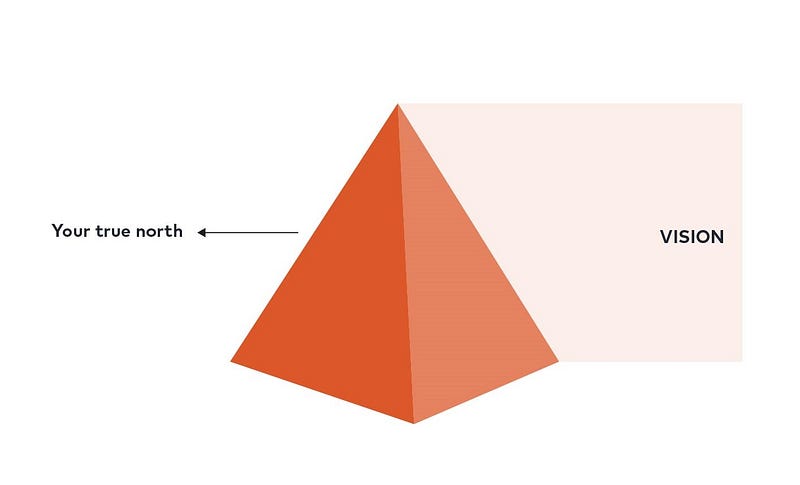
Vision pillars are the long poles in the tent
Like the foundation of a home, you need pillars to support your vision. Think of these as the ways in which you will reach your vision — the “how”. After aligning around its vision, your team might play the following mad libsexercise to construct its pillars:
“Our vision is to [insert Team Vision], by [Pillar #1], [Pillar #2], and [Pillar #3].”
You can have any number of pillars, but I’ve always found three to be the magic number, as it’s symmetric and easy for people to digest and recall. In the case of our digital wallet business, we choose the following three vision pillars:
1. Build the Foundation (i.e. gaining parity with the competition and building a reliable, well-performing solution)
2. Delight our Customers Uniquely (i.e. offering a user journey that will completely amaze and impress our users)
3. Deliver Value to Suppliers (i.e. driving economic benefit to the supply side of our dual network)
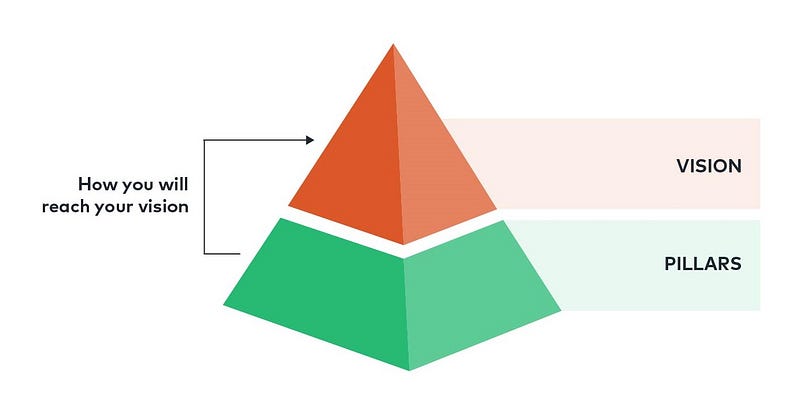
Now here’s the really cool part — after aligning on our pillars, everything we do as a team tethers to those foundations: We’ve created a mechanism around which our team can coalesce.
Our feature brainstorming sessions can be broken out along these pathways — coming up with ideas that align to each pillar. (This structure can also help us push back on ideas that may seem off-track during collaboration sessions.) And our product roadmap becomes classified and color-coded so that every piece of development is accountable to building out one or more of our pillars. The same goes for our user stories in JIRA or any other tool. At the end of the day we can track the percentage allocation of our roadmap dedicated to each pillar to help us understand empirically how we are choosing to climb towards our vision. Here is an example of a past product roadmap I’ve used under this framework. (It has been abstracted to protect company privacy)
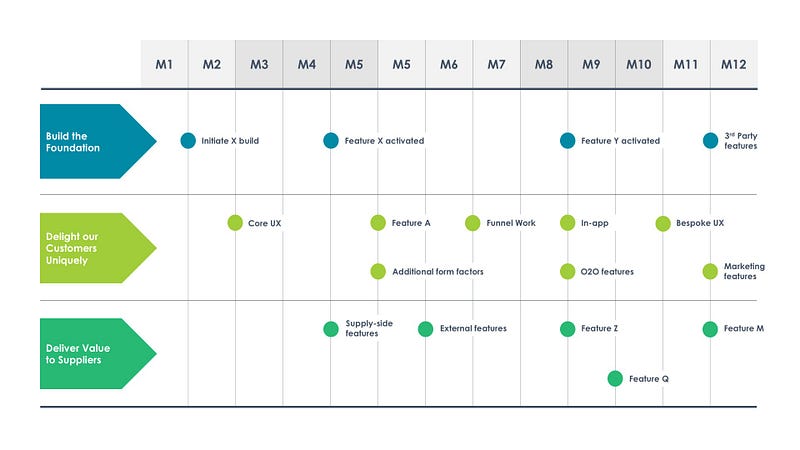
Metrics are all that matter
Next we define our KPIs and success metrics. We do this after establishing our pillars rather than immediately after our team vision, because if set at the right altitude, our vision is more visceral and harder to gauge daily. Our pillars, on the other hand, are more operational day-to-day, and therefore easier to measure on that same basis.
And thus, our KPIs and success metrics are mapped to each pillar. This helps our team immensely by allowing everyone to understand and appreciate the criticality of our metrics and why they matter. I firmly believe that having a data-driven mindset is the top contributing factor to the success of any startup.
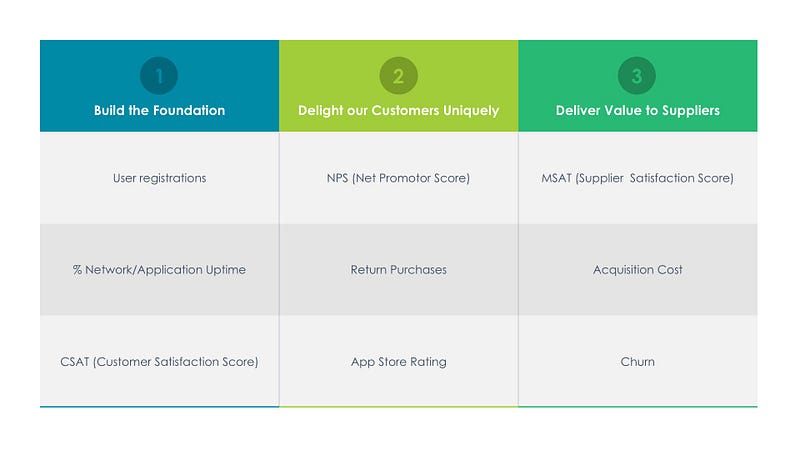
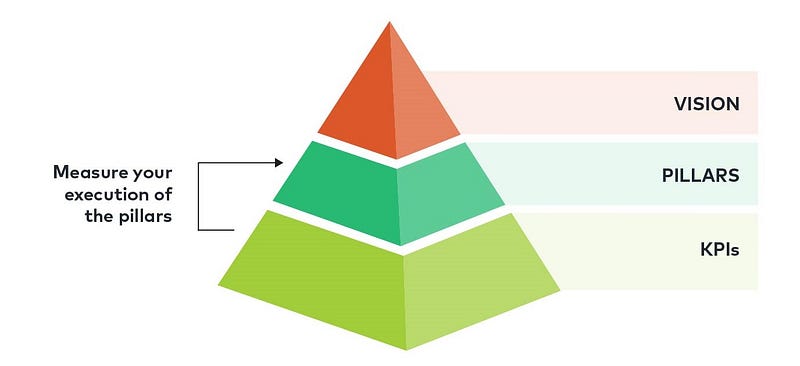
Apply stage gates to avoid biting off more than you can chew
Now that we’ve established where we are going, how we will get there, and how we will measure our success, the next job to be done is to break down our longer term vision into discrete and digestible parts. Not doing this would be like building a rocket ship and trying to launch it to Mars before we’ve even gotten it off the ground at Cape Canaveral. Formally we call these stage gates. Stage gates represent a phased grouping of milestones in our business that we seek to deliver on. The milestones can take on a variety of categories. They can be operational, organizational, commercial, product, or marketing driven in nature (to name a few categories). They may include the attainment of our target KPIs.
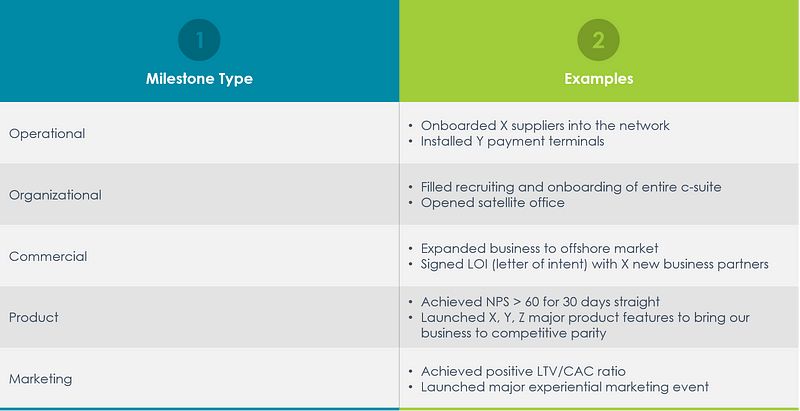
Stage gates serve multiple operational functions. They allow our team to organize a near term workplan around them, as we will discuss momentarily. Also, their attainment may trigger a key decision to be made by the team and/or leadership. In the case of venture capital, and in the companies we work with at BCGDV, many times the attainment of a stage gate triggers the disbursement of an additional tranche of funding by the Board. Other times reaching a stage gate, or failing to do so, may signal the need to make a key decision to pivot, persevere, or expand.
I recommend that your stage gates are attainable within at least a quarterly basis. That way the team can set feasible objectives and deliverables, and a clear workplan around those goals. Your stage gates may also change mid-stream. This flexibility allows startups to stay nimble and agile in reacting to market demands and customer feedback. Though you should seek to minimize these fluctuations so as not to unsettle your team with changing priorities.
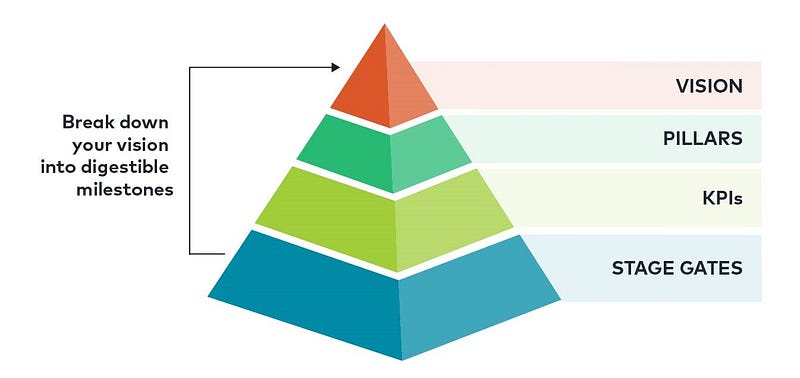
Align on a workplan
Our vision, pillars, KPIs, and stage-gated milestones are now in effect. All that remains for our rocket ship startup to blast off into space is execution. This is where the winners of the startup world are decided. Managing the operations and execution of any startup is no easy chore; it takes a careful choreography to align all parts. This is precisely where we find the greatest value in our team workplan, which scaffolds down from the upper parts of our Startup Ops Pyramid.
At the beginning of every stage gate phase, I like to work with each team member to construct an initial spreadsheet list of activities (i.e. workplan) that they will be accountable for completing to help the team achieve its milestones during that cycle. (Note: The engineering team has visibility into this process, but generally their workplan is ironed out through a more traditional agile sprint plan).
Then, on a weekly basis, each operating team member is asked to update their workplan based on the real-time view of the business. As they complete each activity they strike through them in the spreadsheet. They can also add or modify activities, and highlight those that are on the critical path. The team meets for one hour, and in a process similar to a daily stand-up, every activity owner shares the updates he or she has made to his or her plan. During this roundtable process we make sure not to go too deep into content, to ensure that the session moves at a pace that will keep everyone’s attention and not run over. Just like a daily stand-up, if needed blockers and dependencies can be called out.
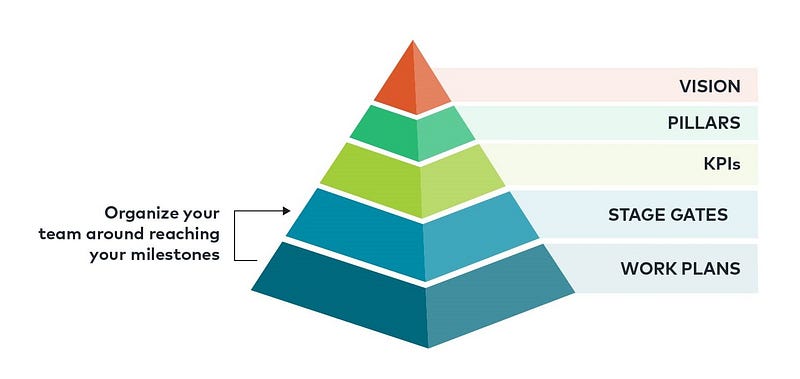
I’ve used tools ranging from Trello to Pivotal Tracker to FreedCamp to memorialize the team workplan. But I’ve found using a simple Google Spreadsheet or Airtable base to be the most effective approach. It allows for concurrent usage and collaboration, is inexpensive and/or free, and allows the team to adjust the prioritization of activities through simple drag and drop functionality.
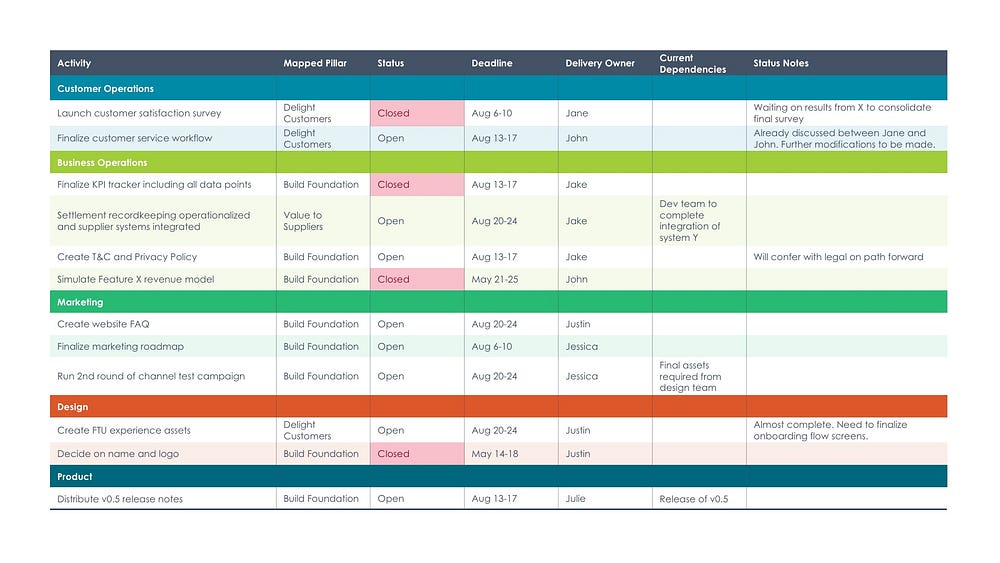
Creating the right environment
The Startup Ops Pyramid is formulaic and simple enough in its approach. We don’t actually need to use rocket science to launch the rocket ship. Yet what we do require is a working environment that will allow the team’s operations to flourish — and this comes down to having a supportive team culture. Culture is the bedrock of any startup. And while every team’s culture is wonderfully unique in its own way, I do believe there are two key cultural ingredients that need to be in place for the Startup Ops Pyramid to be successful: transparent communication, and a team values system.
Practice transparency
Consider how overt the pyramid process is from start to end. Creating the true north vision and pillars is a collaborative effort. KPIs and targets are shared openly with the team in real-time. And each member’s workplan is made publicly available as a forcing function of alignment. It is completely transparent, and it requires an openness and willingness by everyone to accept a certain level of vulnerability. To allow for this environment to take place, it’s critical that the team operates with radical candor. Radical candor is a transparent form of communication described by former Google executive Amy Scott in her 2017 book Radical Candor, and is a protocol I highly recommend. It means challenging others directly while maintaining a sense of care and empathy for their interests and viewpoints. I view the creation of this environment as the role of the team leader — to set the example for others to follow. Without it, team members may retreat back to working in silos, the avoidance of which is the entire goal of the pyramid.
Instill cultural values
Another way to ensure that everyone on the team is driving towards the same goals is to make sure that they share a set of common values. People’s personal lives and personal values may differ of course, but as a team it is important our startup has a single value system that is promoted and evangelized. At the very start of our digital wallet incubation, we hosted a workshop among the working team to discuss our team values. The conversation was uncomfortable, trite, and didn’t stick. But that’s because we weren’t yet sure of our vision and most of us were completely new working together. We held the same session four months later to the tune of dramatically different results. After a short amount of time getting to know each other, it was clear that there was much greater comfort in defining our value system. Each team member took a few moments on their own and wrote down possible values on Post-its. We then went around the group and shared each proposed value, lassoing together like-minded ones on the whiteboard. From those lassoed clusters together we derived the final team values, doing our best to accurately capture the spirit of the now consolidated Post-it notes.

The result of this exercise was a series of five team values that the team believes in and helps drive our modus operandi. I highly recommend it.
· Impact over words
· The only bad idea is the one unspoken
· We fight for the right to delight customers
· Reach beyond our comfort zone
· We are family
As the team grows, the challenge is to maintain the credence in and influence of your team values across new team members. This can only be done by bringing your values to the forefront of your team’s operations. Consider techniques such as evaluating job candidates based on each value. Or publicly praising and rewarding when team members exhibit your values in exemplary ways (Starbucks gift cards make a great carrot to dangle). Whichever tactic works best for your organization, just make sure that everyone on the team is aware of your values.
Bringing it all together
As all entrepreneurs know, there’s no one-size-fits-all way to operate a business. The Startup Ops Pyramid is a playbook that has worked well for my teams in the past, and hopefully can work well for your team as well. No matter what modus operandi you select, the key is to be consistent and to have discipline. Not every team member will immediately acknowledge the method that you’re installing or appreciate the fortitude it takes to introduce a new methodology to the team. So have patience. Channel the passion you have for making a change in the world into the process you use to operate your startup and the rest will follow suit. Good luck, and enjoy the ride.
Note: ** Originally Published on Medium Startup Grind



